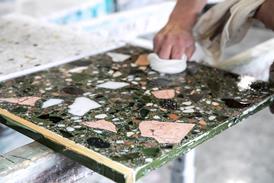When designing the heating and cooling system for Gloucestershire Constabulary’s new headquarters, the engineers came up with an arresting solution. Andy Pearson investigates its green credentials
Gloucestershire Constabulary’s new £19m headquarters is unusual. For a start, it is the UK's largest ground-source heat-pump scheme; but what really differentiates this scheme from a raft of other geothermal schemes is that it has been built under the Private Finance Initiative.
It’s fair to say that PFI projects don’t generally have a reputation for innovation. This is understandable, given that a PFI consortium has to live with the consequences of a design for 25, or even 30 years. But, when it came to the design of the 8500 m2 Constabulary’s headquarters, the scheme's designer and building services engineer, McBains Cooper, managed to persuade the Reliance/HBOS consortium that innovation was essential to meet the scheme’s demanding brief.
The Constabulary wanted its headquarters, based in Quedgeley, Gloucester, to be an environmentally friendly, low-energy, building with a BREEAM rating of ‘excellent’. The problem was it also wanted a building that provided comfortable internal temperatures, 24 hours a day, year-round for 400 staff. In fact, the brief stipulated that if internal temperatures were to rise above 248C, the PFI contractor would be subject to "severe penalties," according to Anthony Coumidis, director of engineering at McBains Cooper.
The risk of internal temperatures exceeding this limit ruled out natural ventilation as a low-energy solution. "To guarantee low temperatures, we needed mechanical ventilation with cooling," explains Coumidis. However, a conventional air conditioning system would have made it difficult to achieve a high BREEAM rating. In the end, a geothermal solution using a reversible heat pump was found to be the most effective way to resolve these apparently conflicting demands throughout the year. As Coumidis says, "The geothermal solution was the only way to achieve BREEAM 'Excellent' using mechanical ventilation".
The system works by extracting thermal energy from 180 boreholes, containing loops of pipework, sunk deep into the ground. To maximise energy storage and to provide the system with some resilience, the boreholes have been drilled in two discrete fields, each of which is on a separate loop. The loops connect to a common header, where a total of nine heat pumps provide the heating and cooling. Fluid circulating through the loop absorbs the stored heat and transfers it to the heat pump.
Seasonal adjustments
In the winter, the system will remove heat from the ground at around 10°C. The heat pump then upgrades and transfers this energy to the heating system. In summer, the system is reversed so that heat is extracted from the building and transferred to the cooler ground.
Coumidis was concerned that during the summer cooling season, the ground would have insufficient capacity to deal with the peak cooling loads. To pre-empt any possible shortcoming, a dry cooler, consisting of a coil and fan, has been installed in the car park to dissipate excess heat from the ground loop circuit to the atmosphere.
The building's peak cooling load of 765 kW, together with a total heating requirement of 646 kW, demanded that the coils have a large area in contact with the ground. The headquarters sits on top of clay, which is a poor conductor of heat, so the borehole contractor, Geothermal Heating, had to drill to a depth of 98 m to absorb sufficient heat for the building.
The heat pumps can achieve 50°C/40°C flow/return temperatures for heating and 7°C/12°C for cooling. To use these temperatures effectively, an underfloor heating and cooling system has been used for the ground floor rooms where temperatures were less critical – it includes a gym, sports hall and restaurant. Conditions in the offices on the upper floors are maintained using a fan coil system, with heating coils sized to take account of the lower hot water temperature.
A geothermal system generally provides 30–40% energy savings compared with conventional air-conditioning
The heat pumps will also preheat the domestic hot water via a heat exchanger. This is a significant load, since the catering department will be producing around 800 meals a day. Direct-fired gas hot water heaters will provide top-up heat.
A further 125 kW of cooling is required for specialist IT equipment, so the IT rooms are fitted with dual circuit cooling units. Ordinarily, these units run on a chilled water circuit so that the waste heat from the computer room can be used elsewhere in the building. Given the important role that IT plays in the police force, the system is backed up using a conventional refrigerant-based cooling system.
Coumidis expects the use of a geothermal system to have significant environmental and cost benefits – the energy consumed by this type of system is less than the energy it produces. "A geothermal system will generally produce energy savings of 30%–40% when compared to a conventional air-conditioning system," he explains. In fact, when the solar shading and enhanced fabric insulation are taken into account, the building is expected to have a carbon rating of 13.5 kgC/m2/year, which is 5 kgC/m2/year lower than a comparable air-conditioned building.
In addition to reduced running costs, another advantage of the system is that it needs very little plant space. Coumidis points out that the heat pumps in the Gloucester scheme occupy the space of nine filing cabinets, which enabled them to keep the building's giant curved roof free of cooling and heating plant. Maintenance costs, too, are expected to be lower than those of a conventional boiler system.
Spreading the word
The success of the ground-loop scheme in Gloucestershire has prompted its use on other PFI schemes. In Kent, McBains Cooper is currently working on a second PFI police headquarters for the RHM consortium. However, rather than have a separate area of boreholes for the ground loop pipework, site constraints mean that in this scheme, the geothermal pipework has been incorporated into the building's structural piles. Coumidis explains this method of construction is potentially cheaper, since it requires fewer boreholes – however, to be successful it does require close collaboration between the building and borehole contractors.
McBains Cooper is also using ground source heat pumps on schemes other than PFI, including a new B&Q store and a £18m housing development in North London. So is the geo-thermal solution suitable for all schemes?
What made the solution appropriate for this project was the fact that it was a PFI scheme, which allowed the designers to calculate the payback over a longer period of time. "The fact that it was a PFI scheme and not a speculative building where the developer wanted an immediate payback meant we could talk about a payback of seven to eight years." Coumidis says. "What's more," he adds, "with the price of energy continually increasing, the payback period becomes ever shorter." n
Source
Building Sustainable Design




















_copy.jpg)
_copy.jpg)
